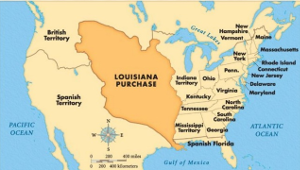The Making of the 50 States: Missouri
Part 2: The Rest of the Story
France regained control of Missouri, along with the rest of the Louisiana Territory, in 1800. Ownership of all of that land passed from France to the United States as part of the Louisiana Purchase in 1803. The very next year, the famed expedition led by Meriwether Lewis and William Clark spent time in Missouri, visiting St. Louis and traveling up the Missouri River, before heading west. Many more explorers and settlers would follow. The Missouri River on the west and the Mississippi River on the east provided many opportunities for trade, exploration, and settlement. It wasn't long before Missouri became known as the "Gateway to the West." When the Territory of Louisiana was established in 1805, St. Louis was the seat of government. More forts and settlements followed. The fur trade was still lucrative. William Clark was a prominent member of the Missouri Fur Company, begun in 1809. The territory's first newspaper, the Missouri Gazette, had come along a year earlier. The U.S. established the Missouri Territory in 1812. The first territorial governor, James Wilkinson, proved not at all adept at his job, even at one point throwing in his lot with Aaron Burr when he tried to overthrow the United States. Wilkinson was removed from office and replaced by Meriwether Lewis. William Clark was Missouri's last territorial governor. American settlers and soldiers built forts in several locations in the Missouri Territory. The War of 1812 was fought mainly elsewhere, although a few skirmishes took place within Missouri's borders, including the Battle of the Sink Hole, one of the last of the war. The Missouri Rangers, who patrolled the Missouri River and the Mississippi River, were commissioned during this war. 
Missourians first petitioned the U.S. Government to join the Union in 1817. Complicating the issue was the allowance in Missouri of slavery and an ongoing struggle between North and South for balance between states that did allow slavery and states that didn't. Breaking the impasse in the end was the Missouri Compromise in 1820. Under the terms of that agreement, the Union would admit two states, one that allowed slavery and one that didn't. Maine was the state that didn't. Missouri became the 24th state on August 10, 1821; the state capital was St. Charles. First page > In the Beginning > Page 1, 2
|
|
Social Studies for Kids
copyright 2002–2024
David White





